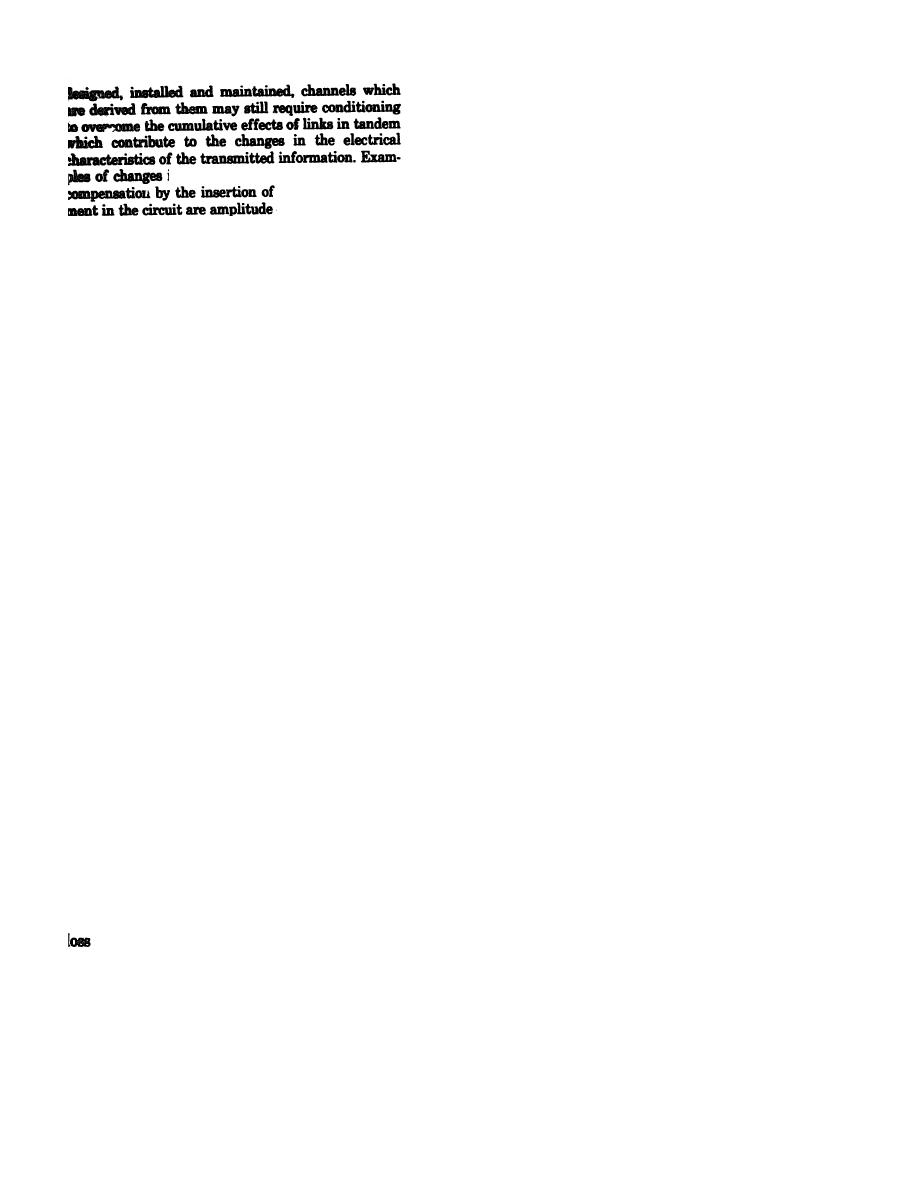 |
|||
|
|
|||
|
|
|||
| ||||||||||
|
|
 TM 11-5895-1012-10
or amplifier circuits to compensate for differences in
attenuation due to differing impedances at the various
frequencies being used. Adjustments are usually pro-
vided to accomplish the required equalization.
d. Envelope Delay Equalizers.
(1) There is still another way in which voice-grade
in electrical characteristics requiring
circuits can vary with frequency, and that is in the
conditioning equip
velocity of propagation. This variation does not usual-
distortion, envelope
ly affect speech transmission, but it can have an ad-
delay, signal level changes, and longitudinal balance.
verse affect on data transmission.
2-31. Circuit Conditioning Equipment
(2) In any circuit there is a finite time interval for
transmission from the sending end of the circuit to the
The following is a brief description of circuit condition
receiving end. This time is referred to as absolute de-
equipment used on the DCS and found in the Technical
lay and varies according to the facility used. This time
Control Facility.
interval will also vary considerably between various
a. Pads. Pads, which come in many forms and physi-
frequencies in the transmitted band. This means that
cal arrangements, are used to attenuate signals within
the shape of a signal wave at the receiving end can dif-
a circuit. Pads found in telecommunications normally
fer to an appreciable degree from that originally ap-
have the same input and output impedance; however,
plied at the transmitting end. This distortion is called
they can be designed to match impedance of different
envelope distortion; and it is measured in microsec-
values. The attenuation introduced by a pad is varia-
onds of envelope delay.
ble, most usually by using different strapping options
(3) Envelope delay distortion is the result of the
to adjust the amount of attenuation in steps of 0.5 dB.
deviation of the phase shift from a straight line pat-
b. Amplifiers. An amplifier is used to increase sig-
tern across the frequency band of interest. In carrier
nal strength without introducing appreciable distor-
systems, the variation in time and frequency is caused
tion and to compensate for attenuation of signals on vf
mainly by the channel filters. Often additional distor-
channels. Transistorized and vacuum tube amplifiers
tion will be found in the outermost channels of a car-
will be found in use on the DCS. Typical amplifiers
rier group. This effect will be more noticeable in some
used in circuit conditioning have an adjustable gain of
systems than in others and is caused by the filter cut-
from zero to 35 dB at 1000 Hz, stabilized within .2
off. Normally, it is good practice to avoid the lower
dB and with a frequency response from 300 to 3400
Hz. Input and output impedances are usually 600 ohms
and upper channels of a group or channels adjacent to
pilot tones when channels are being assigned for data
balanced.
service.
c. Amplitude Equalizers.
(4) Although delay distortion is found in cable and
(1) Decreased intelligibility in voice circuits can be
caused by the unequal attenuation of different fre-
channel terminals, it should be remembered that
equipment units, such as repeaters and coils, also
quencies. For example, as various frequencies pass
along a nonloaded cable, the high frequencies are at-
contribute to delay distortion. These units affect the
tenuated more than the lower ones. A l-mile section of
frequencies below 1000 Hz to a greater extent than
26-gauge high-capacity cable will have a loss of about
those above 1000 Hz. In calculating the overall
1.4 dB at 250 Hz; however, at 3000 Hz, the loss will be
envelope delay of a circuit, the delay inherent in each
4.5 dB, a difference of 3.1 dB per mile. Therefore, a 4-
equipment unit or line facility section, at specific fre-
mile section of 26-gauge nonloaded cable will result in
quencies, is summarized. When the delay of the
a 5.6 dB loss at 250 Hz and an 18.0 dB loss at 3000 Hz.
equalizer is added to that of the equipment and facil-
The 1000 Hz loss of the 4-mile loop would be 10.7 dB.
ities, the result should be within the limitations for the
The loss across the band, taken at these three fre-
circuit being implemented.
(5) For individual circuits which will be switched
quencies referenced to the 1000 Hz loss, would be 5.1
in tandem to form a completed connection, the delay
dB less loss at 250 Hz and 7.3 db more loss at 3000 Hz.
(2) The variation in loss across the band of in-
requirements are much more stringent than for the
terest can be compensated for by equalizing. The
overall connection. It is necessary, therefore, that each
equalizing process consists of inserting into the circuit
circuit, whether an interswitch circuit or access line,
additional loss which varies with frequency. Sufficient
fall within the delay distortion limits established
is added at each frequency to bring the response
under the transmission plan for the system involved.
across the band within a specified limit referenced to
This limit will be stated in the Circuit Layout Record
the loss at a specified frequency, usually 1 kHz.
(CLR) Card for the circuit.
(3) The amplitude equalizer is any combination of
(6) There are two general types of equalizers used
coils, capacitors, or resistors inserted in transmission
to compensate for the effects of envelope delay. One of
2-35
|
|
Privacy Statement - Press Release - Copyright Information. - Contact Us |